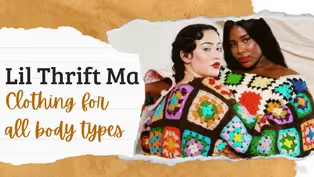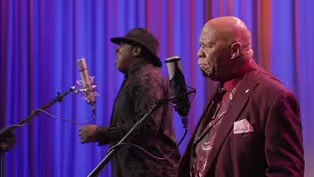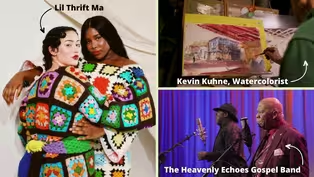
Discovering Albany's Urban Beauty with Kevin Kuhne
Clip: Season 9 Episode 17 | 7m 47sVideo has Closed Captions
Explore watercolorist Kevin Kuhne's local urban landscapes.
Join award-winning watercolorist Kevin Kuhne as he delves into his passion for depicting local urban landscapes. From his studio in Albany, Kevin shares insights into his artistic journey, discussing his background in art education, his unique approach to watercolor, and the inspiration behind his vibrant creations.
Problems playing video? | Closed Captioning Feedback
Problems playing video? | Closed Captioning Feedback
AHA! A House for Arts is a local public television program presented by WMHT
Support provided by the New York State Council on the Arts (NYSCA), M&T Bank, the Leo Cox Beach Philanthropic Foundation, and is also provided by contributors to the WMHT Venture...

Discovering Albany's Urban Beauty with Kevin Kuhne
Clip: Season 9 Episode 17 | 7m 47sVideo has Closed Captions
Join award-winning watercolorist Kevin Kuhne as he delves into his passion for depicting local urban landscapes. From his studio in Albany, Kevin shares insights into his artistic journey, discussing his background in art education, his unique approach to watercolor, and the inspiration behind his vibrant creations.
Problems playing video? | Closed Captioning Feedback
How to Watch AHA! A House for Arts
AHA! A House for Arts is available to stream on pbs.org and the free PBS App, available on iPhone, Apple TV, Android TV, Android smartphones, Amazon Fire TV, Amazon Fire Tablet, Roku, Samsung Smart TV, and Vizio.
Providing Support for PBS.org
Learn Moreabout PBS online sponsorship(gentle music) - I am a local Albany artist who specializes in watercolor, but also does printmaking and three dimensional constructions.
And I think of myself primarily as an art teacher.
And that has always been a love of mine, the actual teaching of the subject.
But I still do a lot of my own work.
I have a degree in art education, and there were really not too many teaching jobs back then at the time and after a while I found myself cooking in restaurants and I just kept cooking in restaurants and worked my way up.
I was a food service director.
I was an executive chef for a while.
I did all that stuff.
It was hard and brutal and tiring, but I never stopped painting.
I never, never stopped drawing and painting.
Always did it on my days off.
(gentle music) It's kind of like I have to.
It's like exercise and nourishment and all that other stuff.
(pan sizzling) A lot of times with cooking, I'm not very big on following recipes.
I'll get the recipe, and the recipe sort of gives you that little roadmap where you wanna go.
And then once I get going, whatever, different things happen, you know, I throw in different things or I cook something longer or shorter than I should and I just play around and combine different ingredients.
And a lot of times with watercolor, you know, watercolor kind of tells you where to go.
You start the watercolor with this plan, you do all this planning, but the watercolor has a mind of its own.
And then hopefully it'll come out okay.
And sometimes it doesn't come out okay, and then you just, you just throw it away or you convince the person that you're serving it to that it's just fine, you know?
(gentle music) My watercolor work, I think in terms of subject matter, you're gonna see mainly buildings and structures and parts of buildings.
I've always been really, really attracted to that subject.
Even as a kid, like down in the basement I have the remains of my old model railroad.
And when I was a kid, I had a model railroad, but the trains never ran.
I could never, you know, the electrical wiring and the tracks wasn't that important to me.
I was always building the scenery and the buildings to go with it.
So I've always been attracted to buildings.
(gentle music) I'll just see some nice colors and shapes in any neighborhood.
You know, not so much in the nice suburban neighborhoods, I like the older neighborhoods.
And I'll sit in my car or sit on a curb or a rock or any place I can find, and I'll just start sketching away.
And I'm quite knowledgeable in perspective.
But if you look at my paintings, you'll see that sometimes the buildings seem to be tilted or moving a little, or they're not exactly perfect in their perspective.
I'm trying to create, like a life in the building, like it's a living, breathing, that's the biggest compliment people have.
One of the biggest compliments people have given me is, like oh, your buildings look like they're alive.
And that's how I sense and I see them as characters, as individual people.
I'm not worrying so much about if everything is perfect.
I never use a ruler, never.
I mean, matter of fact when I see someone else drawing with a ruler, I go huh, how can you do that?
(laughing) (gentle music) I always love to draw and paint on the spot.
And watercolor is very easy to, you know, it's easy to transport, it's easy to clean up, it's easy to pull 'em out real fast and work.
A lot of artists are afraid of watercolor, but one of the ways you can control it is by the planning.
So the process becomes very important.
(gentle music) I will spot something I like, and then I'll pull out a little sketchbook and I'll do a couple of little sketches of it to kind of get my composition and design.
Then I might do a sketch in color.
I might run out of time and then come back the next day.
If you can find two days in a row in Albany where the lighting and the weather is the same, come back and do just a small watercolor sketch.
So there's a lot of planning involved.
And then when I get what I want if I like it, then I might come home and pull out a big sheet of watercolor and work down in my basement studio.
(gentle music) But by then I kind of know where I'm going.
I know where I'm going so it's not a big surprise anymore.
Color is very intuitive.
My approach to color is I look at a scene and it depends, maybe the thing that caught my eye was the fact that it was this brilliant pink building with some greenery right next to it and I like the way those two colors work together.
I said I'm gonna do a pink and green painting.
Or it might be a nice sunny day and I'm feeling, oh, all these warm colors.
So I'll under paint the whole thing in yellow ochers or raw sienna and new gamboge and just work around that and then build up contrast with a few cool colors.
That's kind of how I approach color.
I try not to get too hung up on the local color of something.
The, you know, just because the grass is green, you know, I might think that, well, you know, this building is red here.
The grass might look a little better as an orange color.
So I'll change that in an expressive way to achieve what I want.
(gentle music) How do I know a watercolor is done?
Wow.
You know, I always joke about that in my classes.
You know, you got this watercolor, looks pretty good.
And then the famous last words, just one more stroke there.
You know, and I'm like oh, what did I do?
It's difficult.
What I do and what I've been telling my students to do, is when you reach that point where you're really like, I don't know, am I gonna overwork it?
Is it not good?
Should I do more?
That might be the time to stop right there, put it aside, sleep on it for a couple of days, look at it next week, and very often you'll say oh yeah, maybe I should do a little there or maybe.
You gotta distance yourself from it a little.
Don't make that decision right when you're painting.
And don't give up.
You're gonna have a lot of failures.
I would say outta my watercolors, I'm doing really well if maybe one out of four I keep.
I have portfolios that are filled with watercolors that I'm not, I'll never show, you know.
I don't want to throw 'em away, but I'm not gonna show 'em.
Sometimes I might go back and fiddle with 'em, but not usually.
I just kind of look at 'em and I see oh, those are the ones that didn't work out.
So if you can get one outta four watercolors, but you should be happy if you can get one out of ten.
So that's another thing to think about.
The big secret to watercolor is you never make a mistake.
See, everything that happens on the paper, you tell everybody you did it on purpose.
And then therefore you haven't made a mistake.
And that way it gives you some confidence.
Body Positivity in Fashion: The Art of Lil Thrift Ma
Video has Closed Captions
Clip: S9 Ep17 | 10m 16s | See how Jammella Anderson transforms thrifted textiles into body-positive fashion pieces. (10m 16s)
The Heavenly Echoes Gospel Band Performs "Testify"
Video has Closed Captions
Clip: S9 Ep17 | 5m 31s | "Testify" with The Heavenly Echoes Gospel Band. (5m 31s)
Watercolor Wonders, Fashion Transformations, & Gospel Inspirations: Preview
Video has Closed Captions
Preview: S9 Ep17 | 30s | Discover watercolor techniques, fashion reinventions & a soul-stirring gospel performance. (30s)
Providing Support for PBS.org
Learn Moreabout PBS online sponsorshipSupport for PBS provided by:
AHA! A House for Arts is a local public television program presented by WMHT
Support provided by the New York State Council on the Arts (NYSCA), M&T Bank, the Leo Cox Beach Philanthropic Foundation, and is also provided by contributors to the WMHT Venture...


















